Ask the Expert: I got this from a funeral and no type of description or care instructions were included I would like to know how to care for it. Thank you.
 Plant Expert Reply:
Plant Expert Reply:
Lora,
Everything you want to know about flowers!
Ask the Expert: I got this from a funeral and no type of description or care instructions were included I would like to know how to care for it. Thank you.
 Plant Expert Reply:
Plant Expert Reply:
Lora,
Ask The Plant Expert: I have had my Anthurium plant two years now. When I got it, it had lovely dark-orange flowers; now it has none. The stem that had the flowers has turned brown and there is only a few small leaves, I have it in the kitchen work top near the window. I water it only when the soil gets a bit dry, I have pebbles in the bottom of the pot and also on the top covering the soil, what could the problem be? – Caroline
Ask The Plant Expert:
I inherited 2 anthuriums (one pink & one red) about a year ago. both had “blooms” at the time. Since then nothing. I’ve been wiping the leaves off and don’t think I am over watering, although I think may need to change the soil medium because it appears to be just regular potting soil. As you will see in the pictures attached they are in bright but not direct light. (The large windows are to the right of the bookcase but face due south.) There are brownish flake-like spots on them; which tend to come off when I wipe the leaves/stems off. Also, they seem to let off a sticky substance that doesn’t seem to be hurting anything really; just need to keep shelf & floor below clean. Any suggestions on what I’m doing wrong? – Tammie
Is a Princess Alexia Violet a type of lily? I have cats and I know that lilies are poisonous to them. I was wondering if a Princess Alexia Violet is a type of lily. -Lorriane
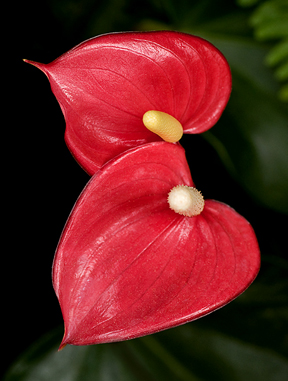 Flower Shop Network Plant Expert Reply:
Flower Shop Network Plant Expert Reply:
Lorriane,
The Princess Alexia violet is a type of Anthurium, specifically Anthurium andreanum. I am not personally familiar with this plant, but I am very familiar with Anthurium scherzeranum, also known as Flamingo flower which is toxic to cats and dogs. I assume the Anthurium andreanum would be as well.
For more information on Anthurium Care click here.
Hope this information is helpful.
Is my plant an in door plant or outdoor plant? Anthedesia Fresh. It is an anthurium with red stamens, big green leaves and it’s roots are over a foot long. I have just re-potted it, but it will need an extremely large pot soon if it is not an out door plant. It was a present and I have not seen one before. I don’t have a photo of it. I just hope you can help me. -Margaret
Flower Shop Network Plant Expert Reply:
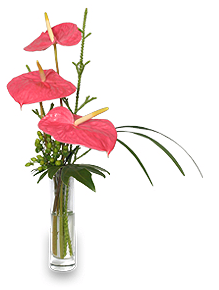 Flower Shop Network has a blog post about the care of Anthurium which is the genus for Antheedesia. Reading Proper Care For an Anthurium Flower should answer many questions about this plant.
Flower Shop Network has a blog post about the care of Anthurium which is the genus for Antheedesia. Reading Proper Care For an Anthurium Flower should answer many questions about this plant.
As for whether it can grow as an outdoor plant in your area, I am not sure. It depends where in the United Kingdom you live. Anthuirum are tropical by nature, and can not be exposed to temperatures below -1.1° Celsius (30° Fahrenheit) and they would really prefer temperatures no lower than 4.4° C and 40° F.
Hope this helps!
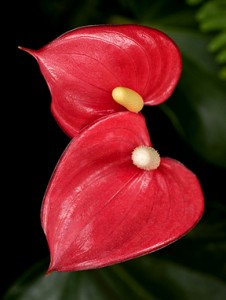 Ask the Plant Expert:
Ask the Plant Expert:
Hi, I have an Anthurium for approx. two years. When i got it, it had one bright red flower. Since then the flower developed, suffering at times, due to my poor care. After learning how to properly care for it, it started to grow ( lots of healthy, big leaves) and then it flowered. Right now it has three whitish flowers, smaller than the initial one. Is it possible to revert the plant to the red color flowers? – Corina
Flower Shop Network Plant Expert Reply:
Corina,
When you say white, do you mean the blooms are faded or are truly white in color. High temperatures (90°) can cause the bloom color to fade or wash out. Although it doesn’t occur often, if the pH of the soil is high, the bloom color can become lighter. Anthuriums are best when the soil pH is 5.5 and a well-balanced fertilizer with Ca, Mg and other trace elements that are used during the non-flowering cycle. During the flowering cycle, you should use a fertilizer with a slightly higher phosphate content like a 20:30:20 or 6:14:7 blend.
As for the smallness of the blooms, your plant may be getting too much light. High light concentration can cause the blooms to be smaller in size. Hope this information is helpful. Please let me know if I can help with anything else.
Ask The Plant Expert: I got a baby anthurium as a Christmas gift, and I have been watering about 300ml of water every second day. Most of the leaves have like brown, dead patches on them, and the flowers are turning brown slowly as well. What do I do?? Please help.
Flower Shop Network Plant Expert Reply: Anthuriums are a tropical plant originating in Central and South America. That means  they need a lot of water and humidity. It is a good idea to mist your anthurium every day and keep watering every other day. You can also keep your anthurium on a tray of pebbles with water to increase moisture and humidity.
they need a lot of water and humidity. It is a good idea to mist your anthurium every day and keep watering every other day. You can also keep your anthurium on a tray of pebbles with water to increase moisture and humidity.
The best rule of thumb is to do the soil squeeze test. Stick your finger down in the soil up to your first joint. Pull a small amount of soil out. If you can roll the soil into a ball and squeeze out water or if the ball stays together, you don’t need to give the plant anymore water. If you can’t roll the soil into a ball and it is powdery, give it some water.
The plant will tend to need more water during the spring and summer even if kept inside. During the fall and winter, you can reduce your watering depending on your specific environmental conditions.
Sunlight could also be a factor for the browning of your anthurium. While, they do enjoy long sunny days, they prefer it to be filtered. Do not put your anthurium in direct sunlight. If you are unable to give your plant filtered sunlight, you can use artificial light. It’s best to give your anthurium at least 9 hours of light a day.
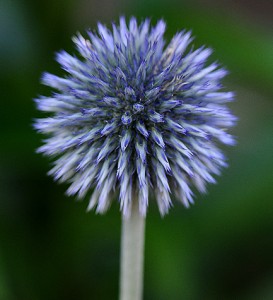 Globe Thistle |
Globe Thistle (Echinops ritro)
Globe Thistle is a clump-forming herbaceous perennial with coarse, prickly leaves with 1-2 ball-shaped silvery-lavender-blue or dark blue flowerheads blooming in early to late summer on rigid branching stems 24-48 inches tall. These beautiful ornamentals grow best in full sun to mostly sunny areas and attract bees and butterflies. In the garden, they will tolerate heat and are deer-resistant. They make excellent cut flowers as well as great additions to dried bouquets.
This flower IS available from your local florist*.
 Allium Bulgaricum |
Allium Bulgaricum (Nectaroscordum siculum)
This ornamental allium is easy to grow, deer-resistant, and hardy to zone 4. They thrive in sunlight and bloom in May and June. Also known as Mediterranean Bells, Sicilian Honey Lily, Ornamental Onion and Sicilian Garlic, they are native to the Mediterranean. The individual florettes begin in an upright position and gradually relax to a cluster of tricolored bells and begin to drape like a floral chandelier. They make an interesting addition to flower arrangements.
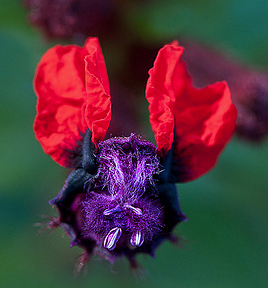 Bat Face Cuphea |
Bat Face Cuphea (Cuphea llavea)
Also known as St. Peter’s plant, Tiny Mice and Bunny Ears, Bat Face Cuphea is a tender tropical evergreen perennial native to Mexico. Bat Face Cuphea prefer partial to full sun and its distinctive red and purple flowers blooms from March through October. Attractive to hummingbirds and bees, the plant is low maintenance, drought-tolerant and makes a great plant for pots, planters, and beds. The plants will grow 2-3 feet tall by 3 feet wide. In early summer, pinch growth off to encourage branching.
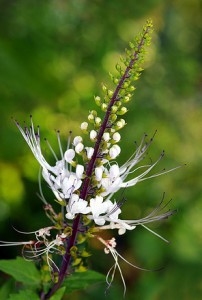 Cat’s Whiskers |
Cat’s Whiskers (Orthosiphon stamineus)
Part of the mint family, Cat’s Whiskers are herbaceous perennial flowering plants originating in tropical East Asia. They grow up to two feel tall and three to four feet wide. The flowers have an orchid-like appearance and are white or lavender, sprouting long stamens that resemble cat’s whiskers. They attract butterflies and hummingbirds and can be harvested to use in herbal teas.
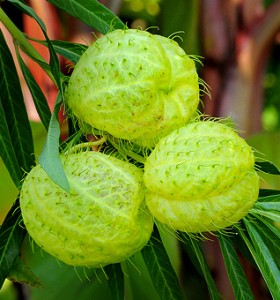 Family Jewels Milkweed |
Family Jewels Milkweed Tree (Asclepias physocarpa)
This species of milkweed is also known as White Butterfly Weed or Swan Plant. Native to Jamaica and South America, this perennial herb can grow to over six feet and prefers full sun and well-drained soil. It is a food source for caterpillars and is a food and habitat plant for the Monarch Butterfly. The small flowers are creamy white and orchid-like, followed by translucent, inflated 2″ green balls covered with soft bristles that are the resulting seedpods. It is a fast-growing tender perennial and grows best in Zones 7-10.
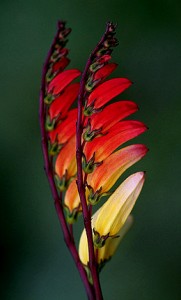 Spanish Flag |
Firecracker Vine or Spanish Flag (Mina lobata)
A tender perennial grown as an annual, this fast climber can grow 10 to 20 feet tall. The incredibly intense-colored 1.5″ blooms are reddish-orange fading to orange yellow and white flowers from mid-summer to fall. Two cultivars include Citronella (cream flowers and red buds) and Mexican Fiesta (red and yellow flowers). A member of the morning glory family, Spanish Flag can be grown in sun to partial shade and is best grown on a lattice.
 Hot Poker |
Red or Yellow Hot Poker (Kniphofia)
Red Hot Poker (Kniphofia uvaria) and Yellow Hot Poker plants are grown from bulbs, and are heat and drought tolerant. They can grow 36″ tall. This variety is ‘Sally’s Comet’ Yellow Hot Poker. Native to Africa, they are known as Torch Lilies. Upright, rocket-shaped blooms produce ample nectar during blooming and are hummingbird magnets. They must be grown in full sun and require good drainage to prevent crown rot. They may spread up to three feet wide. Hardy to zones 5-10.
This flower IS available from your local florist*.
 Liatris |
Liatris or Blazing Star (Liatris)
Hardy perennials White Liatris (Liatris spicata ‘Alba’) and Purple Blazing Star Liatris (Liatris spicata purple), are also known as Gayfeather and Button Snakeroot, and are a member of the Aster family. They bloom from the top down, which is unusual with flowering plants. Each spike is comprised of tiny flowers that are a magnet for pollinators. Ranging from 2-4′ tall, they add height to flower beds and are a popular cut flower in summer floral arrangements with a long vase life.
This flower IS available from your local florist*.
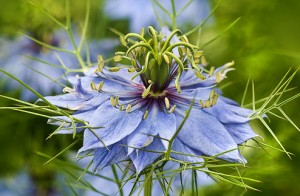 Love-in-a-Mist |
Love-in-a-Mist (Nigella damascena)
Love-in-a-Mist is a beautiful Victorian garden annual blooming in soft shades of blue, pink, white, and lavender. Because its fern-like leaves look similar to fennel, it has also been called fennel flower. This annual herbaceous plant is in the buttercup family (Ranunculaceae), readily self-seeds, and is common in old-fashioned cottage gardens. It grows in full sun to partial shade and blooms from late spring through fall. Nigella is short-lived, so for continuous bloom, repeat sowing every four weeks. You can cut and deadhead this plant to keep it flowering longer.
This flower IS available from your local florist*.
Something Old, Something New…
While going through my emails, I found something NEW I just had to share! In GrowerTalks‘ newsletter, they talk about a European company that has developed a way to dye Anthuriums blue, much like the way they dye the new Blue Mystique orchids. It’s a complicated process, but the results are phenomenal!
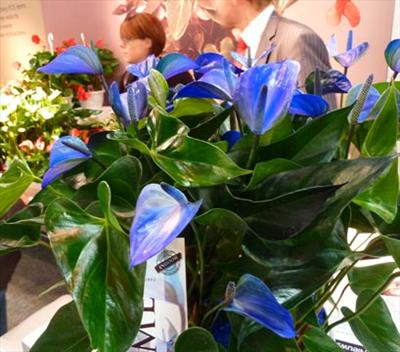
As you can see, the blue is bright and vivid. This new, blue anthurium is called Princess Alexia Blue and is from the Dutch company, Rijnplant. They also offer a yellow one called Princess Alexia Yellow. From their website (and after translating) Rijnplant explains, “The plant is as naturally painted as possible, the dye leaves via root pressure and the assimilative capacity of the leaf.” While I couldn’t find this for sale to florists YET, it’s definitely something to keep an eye out for.
Another cool dyed product to look out for is the colorful new Echeverias. According to GrowerTalks’ newsletter, “One trend that’s been going on [in Europe] for years and continues strong is painting and glittering echeveria. They were everywhere, in every color. Big sellers? Heck, yeah!” [Read more…]
August’s favorite flower color is Peridot green. This year, we are spotlighting unique flower colors for you to use in custom flower arrangements, wedding bouquets, centerpieces and anywhere else you might need great-looking flowers. To make the chosen colors a little more interesting, we are starting with birthstone colors. This month it’s Peridot, or bright green. (Click here for all of our color of the month posts)
Peridot is one of the few gemstones that only occurs in one color, green. The intensity and tint of the green, however, depends on how much iron is contained in the crystal structure. The color of individual peridot gems can vary from yellow- to olive- to brownish-green. The most valued color is a dark olive-green.
Flowers in green are just as unique and striking as the gem, this guide to green flowers will help you when choosing flowers for your events or just for fun!
When creating your wedding bouquet,
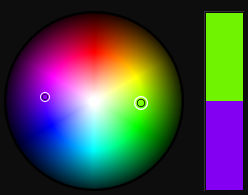

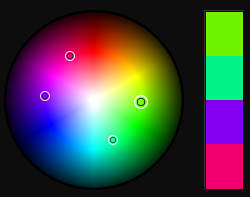
When creating a color scheme using Peridot green, use the color wheel as your guide! Above you see three examples. The first is the complementary color of Peridot green — brilliant purple, which is sure to balance out the bright green. The second is a triad (3) of color complements to light green. Electric blues and hot pinks are sure to add some fun to this combination. You could also go with tetrad (4) of complement colors. So Peridot green, mixed with a close neighbor, aqua, and balanced with purple and hot pink.
Of course, green looks wonderful all on it’s own. Mix different shades and textures of greens together to create a unique and gorgeous flower bouquet.
This is a great flower guide for brides looking for unique color palettes and unusual flowers for their wedding. [Read more…]
Copyright © 2025 · News Theme on Genesis Framework · WordPress · Log in


 Find Your
Find Your